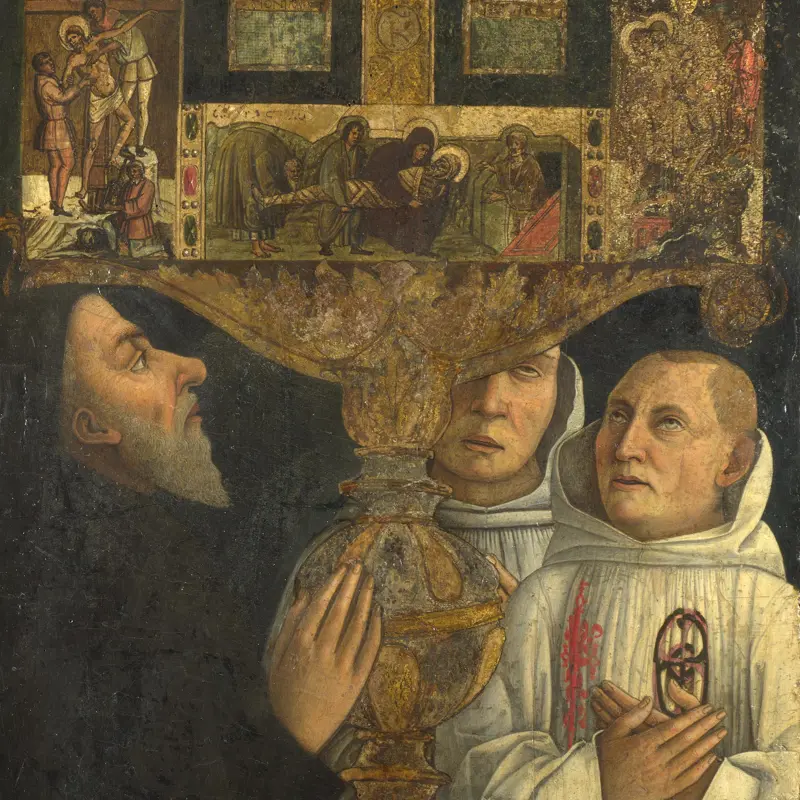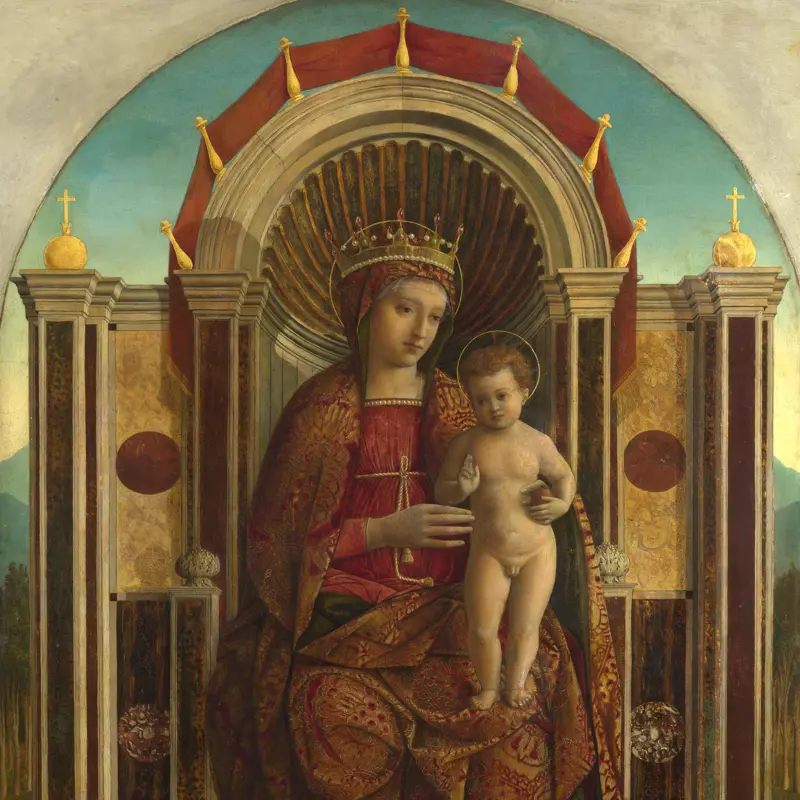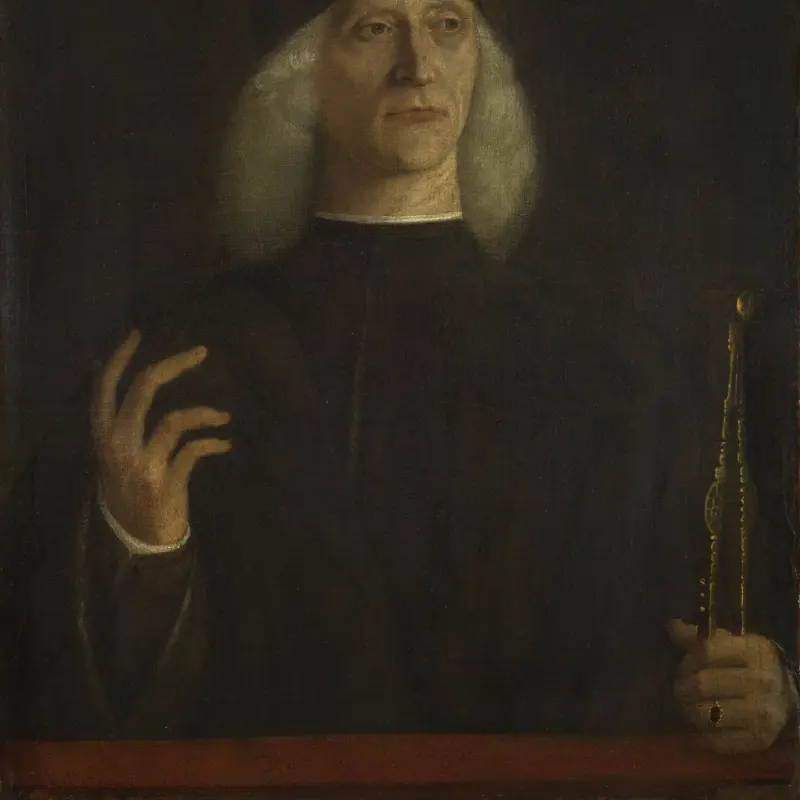Gentile Bellini, 'The Sultan Mehmet II', 1480
About the work
Overview
As ruler of the expanding Islamic Ottoman Empire, Sultan Mehmet II was one of the most powerful men in the world when this portrait was painted. Fascinated by portraiture and European culture, he sent a request for a painter to the Venetian authorities in 1479. Gentile Bellini, having recently completed a series of portraits of the doges (elected rulers) of Venice, was well qualified for the task.
The majority of those portraits were painted in the traditional profile view, but here Gentile has shown the Sultan’s face and body turned slightly towards the viewer, a new fashion in Venice. Although the painting is quite damaged we can still see many meticulous details, like the embroidered cloth hanging over the marble ledge, its many gems and pearls a sign of wealth and magnificence. To further glorify the Sultan, Gentile included three golden crowns on either side of the arch – probably intended to represent Greece, Trebizond and Asia, which Mehmet ruled.
Key facts
Details
- Full title
- The Sultan Mehmet II
- Artist
- Gentile Bellini
- Artist dates
- Active about 1460; died 1507
- Date made
- 1480
- Medium and support
- Oil, originally on wood, transferred to canvas
- Dimensions
- 69.9 × 52.1 cm
- Inscription summary
- Dated and inscribed
- Acquisition credit
- Layard Bequest, 1916
- Inventory number
- NG3099
- Location
- On loan: Long Loan to the Victoria & Albert Museum (2024 - 2027), Victoria and Albert Museum, London, UK
- Collection
- Main Collection
- Previous owners
Provenance
Additional information
Text extracted from the ‘Provenance’ section of the catalogue entry in Martin Davies, ‘National Gallery Catalogues: The Earlier Italian Schools’, London 1986; for further information, see the full catalogue entry.
Exhibition history
-
2008Places of Longing – Travelling with ArtistsLWL - Museum für Kunst und Kultur28 September 2008 - 11 January 2009
-
2009In Search of the Orient. From Bellini to KleeZentrum Paul Klee7 February 2009 - 24 May 2009
-
2013Long Loan to the Victoria & Albert Museum (2013 - 2015)Victoria and Albert Museum1 March 2013 - 30 November 2015
-
2015The Ottoman Orient in Renaissance ArtCentre for Fine Arts (BOZAR)26 February 2015 - 31 May 2015Museum Narodowe w Krakowie25 June 2015 - 27 September 2015
-
2015Long Loan to the Victoria & Albert Museum (2015 - 2018)Victoria and Albert Museum1 May 2015 - 1 November 2018
-
2018Long Loan to the Victoria & Albert Museum (2018 - 2021)Victoria and Albert Museum2 November 2018 - 1 November 2021
-
2021Long Loan to the Victoria & Albert Museum (2021 - 2024)Victoria and Albert Museum2 November 2021 - 1 November 2024
-
2022Marcel Proust. On his mother's sideMusée d'Art et d'Histoire du Judaïsme13 April 2022 - 28 August 2022
-
2024Long Loan to the Victoria & Albert Museum (2024 - 2027)Victoria and Albert Museum2 November 2024 - 1 November 2027
Bibliography
-
1871J.A. Crowe and G.B. Cavalcaselle, A History of Painting in North Italy: Venice, Padua, Vicenza, Verona, Ferrara, Milan, Friuli, Brescia, from the Fourteenth to the Sixteenth Century, 2 vols, London 1871
-
1887F. Kugler, Handbook of Painting: The Italian Schools, eds C.L. Eastlake and A.H. Layard, 5th edn, London 1887
-
1888L. Thuasne, Gentile Bellini et Sultan Mohammed II: Notes sur le séjour du peintre vénitien à Constantinople, Paris 1888
-
1895G. Lafenestre and E. Richtenberger, Venise, Paris 1895
-
1895London, British Library, Add. MS. 38966, Layard Papers: Letter of 24th October from Layard to Morelli, 1895
-
1897B. Berenson, The Venetian Painters of the Renaissance, with an Index to their Works, 2nd edn, New York 1897
-
1921T. Borenius, Catalogue of the Collection of Pictures at Northwick Park, London 1921
-
1927G.F. Hill, A Corpus of Italian Medals of the Renaissance Before Cellini, 2 vols, London 1927
-
1927E. Jacobs, 'Die Mehemmed-Medaille des Bertoldo', Jahrbuch der Königlich Preussischen Kunstsammlungen, XLVII, 1927, pp. 1-17
-
1932B. Gray, 'Two Portraits of Mehmet II', The Burlington Magazine, LXI/352, 1932, pp. 4-7
-
1934W.L. Hare, 'The Portrait of Muhammad II by Gentile Bellini', Apollo, 1934, pp. 249-50
-
1935W.L. Hare, 'A New Gentile Bellini', Apollo, 1935, pp. 111-2
-
1939A. Sakisian, 'The Portraits of Mehmet II', The Burlington Magazine, LXXIV/433, 1939, pp. 172-81
-
1951Davies, Martin, National Gallery Catalogues: The Earlier Italian Schools, London 1951
-
1958G. de Tervarent, Attributs et symboles dans l'art profane, 1450-1600, Geneva 1958
-
1961M. Davies, The Earlier Italian Schools, 2nd edn, London 1961
-
1961F. Babinger, 'Ein weiteres Sultansbild von Gentile Bellini?', Sitzungsberichte der Philosophisch-Historischen Classe der Kaiserlichen Akademie der Wissenschaften, CCXXXVII/3, 1961
-
1961F. Babinger, 'Ein weiteres Sultansbild von Gentile Bellini?', Süddeutsche Zeitung, VI/7-8, 1961
-
1961F. Babinger, 'Un ritratto ignorato di Maometto II, opera di Gentile Bellini', Arte veneta, XV, 1961, pp. 25-32
-
1962F. Babinger, 'Ein Weiteres Sultansbild von Gentile Bellini aus Russischem Besitz', Sitzungsberichte der Philosophisch-Historischen Classe der Kaiserlichen Akademie der Wissenschaften, CCXL/3, 1962
-
1970H.F. Collins, Gentile Bellini: A Monograph and a Catalogue of Works, Ann Arbor 1970
-
1983J. Meyer zur Capellen, 'Das Bild Sultan Mehmets des Eroberers', Pantheon, XLI/3, 1983, pp. 208-20
-
1984J.B. Shaw, 'Gentile Bellini and Constantinople', Apollo, CXX/269, 1984, pp. 56-8
-
1985J. Meyer zur Capellen, Gentile Bellini, Stuttgart 1985
-
1985Museum für Kunsthandwerk, Türkische Kunst und Kultur aus osmanischer Zeit (exh. cat. Museum für Kunsthandwerk, 1985), Recklinghausen 1985
-
1986Davies, Martin, National Gallery Catalogues: The Earlier Italian Schools, revised edn, London 1986
-
1987F.M. Fales and B.J. Hickey (eds), Austen Henry Layard tra l'Oriente e Venezia: Venezia, 26-28 ottobre 1983, Rome 1987
-
1989G. Necipoğlu, 'Süleyman the Magnificent and the Representation of Power in the Context of Ottoman-Hapsburg-Papal Rivalry', Art Bulletin, LXXI/3, 1989, pp. 401-27
-
1991J. Dunkerton et al., Giotto to Dürer: Early Renaissance Painting in the National Gallery, New Haven 1991
-
1994O. Longo, 'Una "soasa" per il Conquistatore: Gentile Bellini e Maometto II', Atti Istituto Veneto di Scienze, Lettere ed Arti (classe di scienze morali, lettere ed arti), CLIII/43193, 1994, pp. 509-30
-
1995J. Paris, L'atelier Bellini, Paris 1995
-
1995Schnitzer and H. Schuckelts (eds), Im Lichte des Halbmonds: Das Abendland und der türkische Orient (exh. cat. Albertina, 20 August - 12 November 1995), Dresden 1995
-
1996M.P. Pedani Fabris, 'Simbologia ottomana nell'opera di Gentile Bellini', Atti Istituto Veneto di Scienze, Lettere ed Arti (classe di scienze morali, lettere ed arti), CLV/1, 1996, pp. 2-29
-
1997D. Bomford, Conservation of Paintings, London 1997
-
1999R. Glover, Gentile Bellini and the Orient: Influence and Effect, MA Thesis, Courtauld Institute of Art 1999
-
1999F. Haskell, 'Venetian Art and English Collectors of the Seventeenth and Eighteenth Centuries', Verona illustrata, 12, 1999, pp. 7-18
-
1999M. Eminoğlu, Ressam, sultan ve portresi (The Artist, the Sultan and his Portrat: Mehmed the Conqueror according to Gentile Bellini) (exh. cat. Yapi Kredi Cultural Center Kazim Taskent Art Gallery, 7 December 1999 - 7 January 2000), Istanbul 1999
-
1999M.P. Pedani Fabris, 'The Portrait of Mehmed II: Gentile Bellini, the Making of an Imperial Image', in F. Déroche (ed.), Arc turc: 10e Congrès international d'art turc. Genève, 17-23 Septembre 1995, Geneva 1999, pp. 555-8
-
2000L. Jardine and J. Brotton (eds), Global Interests: Renaissance Art Between East and West, London 2000
-
2000S. Kangal (ed.), The Sultan's Portrait: Picturing the House of Osman (exh. cat. Topkapı Palace Museum, 6 June - 6 September 2000), Istanbul 2000
-
2001
C. Baker and T. Henry, The National Gallery: Complete Illustrated Catalogue, London 2001
-
2002J. Brotton, The Renaissance Bazaar: From the Silk Road to Michelangelo, Oxford 2002
-
2004M. Bailey (ed.), The Folio Society Book of the 100 Greatest Paintings, London 2004
-
2005C. Campbell and A. Chong, Bellini and the East (exh. cat. Isabella Stewart Gardner Museum, 14 December 2005 - 26 March 2006; The National Gallery, London, 12 April - 25 June 2006), Boston 2005
-
2005D.J. Roxburgh, Turks: A Journey of a Thousand Years (exh. cat. Royal Academy of Arts, 22 January - 12 April 2005), London 2005
-
2006S. Carboni (ed.), Venise et l'Orient (828-1797) (exh. cat. Institut du Monde Arabe, 2 October 2006 - 18 February 2007; Metropolitan Museum of Art, 27 March - 8 July 2007), Paris 2006
-
2008L. Monnas, Merchants, Princes and Painters. Silk Fabrics in Italian and Northern Paintings, 1300–1550, New Haven 2008
-
2008H. Arnhold (ed.), Orte der sehnsucht: mit Künstlern auf Reisen (exh. cat., LWL - Landesmuseum für Kunst und Kulturgeschichte, Münster), Regensburg 2008
About this record
If you know more about this work or have spotted an error, please contact us. Please note that exhibition histories are listed from 2009 onwards. Bibliographies may not be complete; more comprehensive information is available in the National Gallery Library.




